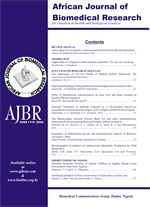
|
African Journal of Biomedical Research
Ibadan Biomedical Communications Group
ISSN: 1119-5096
Vol. 21, No. 1, 2018, pp. 81-85
|
 Bioline Code: md18014
Bioline Code: md18014
Full paper language: English
Document type: Research Article
Document available free of charge
|
|
|
African Journal of Biomedical Research, Vol. 21, No. 1, 2018, pp. 81-85
| en |
Phytochemical Analysis and Evaluation of Antidiabetic Effects in Alloxan-Induced Diabetic Rats Treated with Aqueous Leaf Extract of Acanthospermum hispidum 
Chika, A; Onyebueke, D.C & Bello, S.O
Abstract
The current study is aimed at investigating the antidiabetic activity of the leaves of Acanthospermum hispidum, a medicinal plant
traditionally used to treat diabetes mellitus in NorthWestern Nigeria. Material from the plant was extracted using water (guided
by the traditional mode of extraction) and the phytochemicals contained in the extract were analyzed qualitatively and
quantitatively. Acute toxicity study of the extract was conducted, and diabetic rats induced using alloxan (80 mg/kg administered
intraperitoneally once daily for 3 days) were treated with the extract for 28 days at 3 incremental doses (70, 210 and 700 mg/kg).
At the end of the experiment, fasting blood glucose and glycogen content of the liver and skeletal muscle were determined. The
study findings indicate that the extract was relatively safe with LD50 above 5000 mg/kg. Treatment with Acanthospermum
hispidum extract resulted in a significant (P<0.05) reduction in FBG as well as a significant improvement in oral glucose tolerance
at all doses. A significant elevation in the hepatic content of glycogen was also observed at the highest dose (700 mg/kg). Results
from this study have demonstrated the potent antidiabetic activity of the aqueous extract of the leaves of Acanthospermum
hispidum, thus justifying the traditional claim.
Keywords
Acanthospermum; phytochemicals; antidiabetic; LD50; aqueous extract
|
| |
© Copyright 2018 - African Journal of Biomedical Research
|
|
